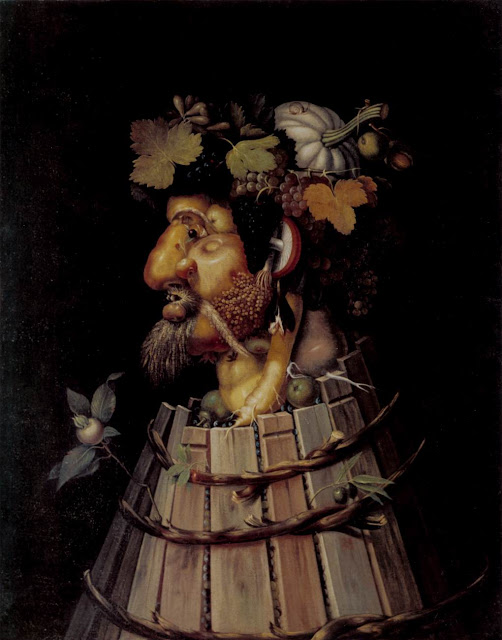 |
1986 Self-Portrait
watercolour and pencil 48.9 x 64.8 cm
© National Portrait Gallery, London
|
This is part 4 of a 4-part post on the works of British Artist Edward
Bawden, one of a group of artists associated with a community of artists
that existed around Great Bardfield in Essex, England during the middle years of the 20th
century.
For biographical notes on Bawden see part 1. For earlier works see parts 1, 2 and 3 also.
-->
In 1967 Bawden made a series of six prints of London markets,
commissioned by Curwen Prints. The markets were Billingsgate, Borough, Covent Garden (2),
Leadenhall and Smithfield:
 |
1967 Billingsgate Fish Market
lithograph |
 |
1967 Borough Market
lithograph 46 x 61 cm |
 |
1967 Covent Garden Flower Market
lithograph 46 x 61 cm |
 |
1967 Covent Garden Fruit Market
lithograph 45.8 x 69.9 cm |
 |
1967 Leadenhall Market
lithograph 46 x 61.5 cm |
 |
1967 Smithfield Meat Market
lithograph 46 x 61.5 cm |
-->
In 1970 Bawden produced a series of
eight linocuts from themes in Aesop's Fables, which he published himself in an
edition of fifty:
 |
1970 Aesop's Fables, A Frog and an Ox
linocut 40.5 x 56 cm |
 |
1970 Aesop's Fables, Jackdaw in Borrowed Feathers
linocut |
 |
1970 Aesop's Fables, Hares Foxes and Eagles
linocut |
 |
1970 Aesop's Fables, Ant and Grasshopper
linocut |
 |
1970 Aesop's Fables, Frog, Mouse and Kite
linocut |
 |
1970 Aesop's Fables, Gnat and Lion
linocut 40.5 x 56 cm |
 |
1970 Aesop's Fables, Hare and Tortoise
linocut 40.5 x 56 cm |
 |
1970 Aesop's Fables, Peacock and Magpie
linocut 40.5 x 56 cm |
 |
1970 Trinity College Chapel, Oxford
lithograph 29.5 x 42.9 cm |
 |
1973 Audley End
lithograph 50.5 x 63 cm |
 |
1978 Neyayah, Rasselas and Imlac
lithograph |
 |
1979 Wingfield Manor, Derbyshire - The Great Hall
watercolour |
 |
1981 Cat and Ball of Wool/Play with Me
linocut |
 |
1982 Book Illustration
linocut
© Victoria and Albert Museum, London |
 |
1986 Among the Marsh Arabs
lithograph 36 x 58 cm |
 |
1986 Cat and Greenhouse, Park Lane, Saffron Walden
watercolour |
The original watercolour of ‘Dunkirk’
(below), painted in 1940, is in the collection of the Imperial War Museum. This
version (colour lithograph on plastic) was made in 1986 by Bawden for the
Curwen Press in an edition of 75:
 |
1986 Dunkirk
lithograph 36 x 58 cm |
+watercolour+&+pencil+48.9+x+64.8+cm+%C2%A9+National+Portrait+Gallery,+London.jpg) |
1986 Self-Portrait
watercolour and pencil 48.9 x 64.8 cm
© National Portrait Gallery, London |
 |
1987 Hound of the Baskervilles
linocut |
 |
An Old Crab and a Young
linocut 37.7 x 24.5 cm |
 |
Corn Exchange, Saffron Walden
linocut 56 x 76.6 cm |
 |
The Blue Plough, Saffron Walden
linocut 56 x 78 cm |





















+oil+on+panel+37.7+x+55+cm.jpg)
























+oil+on+panel+68+x+56+cm.jpg)
























+watercolour+&+pencil+48.9+x+64.8+cm+%C2%A9+National+Portrait+Gallery,+London.jpg)



